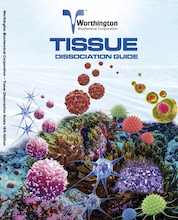For our international customers, please be advised that orders cannot be placed through our website by customers in countries with International Distributor representation.
Worthington Tissue Dissociation Guide
Cell Isolation Theory: Connective Tissue
Connective tissue develops from mesenchymal cells and forms the dermis of skin, the capsules and stroma of several organs, the sheaths of neural and muscular cells and bundles, mucous and serous membranes, cartilage, bone, tendons, ligaments and adipose tissue.
Connective tissue is composed of cells and extracellular fibers embedded in an amorphous ground substance and is classified as loose or dense, depending upon the relative abundance of the fibers. The cells, which may be either fixed or wandering, include fibroblasts, adipocytes, histiocytes, lymphocytes, monocytes, eosinophils, neutrophils, macrophages, mast cells and mesenchymal cells.
There are three types of fibers: collagenous, reticular and elastic, although there is evidence that the former two may simply be different morphological forms of the same basic protein. The proportion of cells, fibers and ground substance varies greatly in different tissues and changes markedly during the course of development.
Collagen fibers are present in varying concentrations in virtually all connective tissues. Measuring 1-10 µm in thickness, they are unbranched and often wavy, and contain repeating transverse bands at regular intervals. Biochemically, native collagen is a major fibrous component of animal extracellular connective tissue, skin, tendon, blood vessels, bone, etc. In brief, collagen consists of fibrils composed of laterally aggregated polarized tropocollagen molecules (M.W. 300,000). Each rod-like tropocollagen unit consists of three helical polypeptide a-chains wound around a single axis. The strands have repetitive glycine residues at every third position and an abundance of proline and hydroxyproline. The amino acid sequence is characteristic of the tissue of origin. Tropocollagen units combine uniformly in a lateral arrangement reflecting charged and uncharged amino acids along the molecule, thus creating an axially repeating periodicity. Fibroblasts and possibly other mesenchymal cells synthesize the tropocollagen subunits and release them into the extracellular matrix where they undergo enzymatic processing and aggregation into native collagen fibers. Interchain cross-linking of hydroxyprolyl residues stabilizes the collagen complex and makes it more insoluble and resistant to hydrolytic attack by most proteases. The abundance of collagen fibers and the degree of cross-linking tend to increase with advancing age, making cell isolation more difficult.
Reticular fibers form a delicate branching network in loose connective tissue. They exhibit a regular, repeating subunit structure similar to collagen and may be a morphological variant of the typical collagen fibers described above. Reticular fibers tend to be more prevalent in tissues of younger animals.
Elastic fibers are less abundant than the collagen varieties. They are similar to reticular fibers in that they form branching networks in connective tissues. Individual fibers are usually less than 1 µm thick and exhibit no transverse periodicity. The fibers contain longitudinally-arranged bundles of microfibrils embedded in an amorphous substance called elastin. Like collagen, elastin contains high concentrations of glycine and proline, but in contrast has a high content of valine and two unusual amino acids, desmosine and isodesmosine. Fibroblasts and possibly other mesenchymal cells synthesize the elastin precursor, tropoelastin, and release it into the extracellular matrix where enzymes convert the lysine residues into the desmosines. Polymerization of elastin occurs during interchain cross-linking of the latter. In this state, elastin is very stable and also highly resistant to hydrolytic attack by most proteases.
The viscous extracellular ground substance in which connective tissue cells and fibers are embedded is a complex mixture of various glycoproteins, the most common being hyaluronic acid, chondroitin sulfate A, B, and C and keratin sulfate. Each of these glycoproteins is an unbranching polymer of two different alternating monosaccharides attached to a protein moiety. Hyaluronic acid, for example, contains acetyl glucosamine and glucuronate monomers and about 2% protein, while the chondroitin sulfates contain acetyl galactosamine and glucuronate or iduronate monomers and more than 15% protein. The relative abundance of these glycoproteins varies with the origin of the connective tissue.
Tissue Tables
The Worthington Tissue Tables provide references useful to researchers interested in tissue dissociation and cell harvesting procedures. The references are organized by Tissue and Species type and linked to PubMed citations. The Cell type, Enzymes, and Medium for each reference is provided.
To search by specific criteria, use the Tissue References Search Tool.
